Can better data help keep prison population down? Nevada's going to try

Nevada’s prison population had taken a welcome dip about 10 years ago.
But then it started ticking back up again — enough that Nevada now houses 200 inmates in an Arizona private prison, and state leaders often ask the Nevada Department of Corrections at public meetings whether they think it’s time to build a new prison.
Clearer answers on why there’s an uptick — and potentially, relief for the overcrowding — could be on the way now that the state has partnered with the Crime and Justice Institute. The organization’s staff will be spending about a year making large-scale data requests from courts, prisons and other agencies, interviewing people who work in the criminal justice system and helping Nevada leaders develop policy recommendations that could become law through the 2019 legislative session.
“Continuing business as usual is not an option for us,” Democratic Senate Majority Leader Aaron Ford said in a statement announcing the partnership. “Our overburdened corrections system cannot continue to divert funds from our state’s necessary educational, healthcare, and economic development programs.”
Nevada is spending $347 million a year on prisons, an increase of 20 percent since 2012. Earlier this year, Gov. Brian Sandoval sounded the alarm when correctional officer overtime costs sharply increased, prompting the state to dip into reserves and eating up money that’s meant to be available to a variety of agencies.
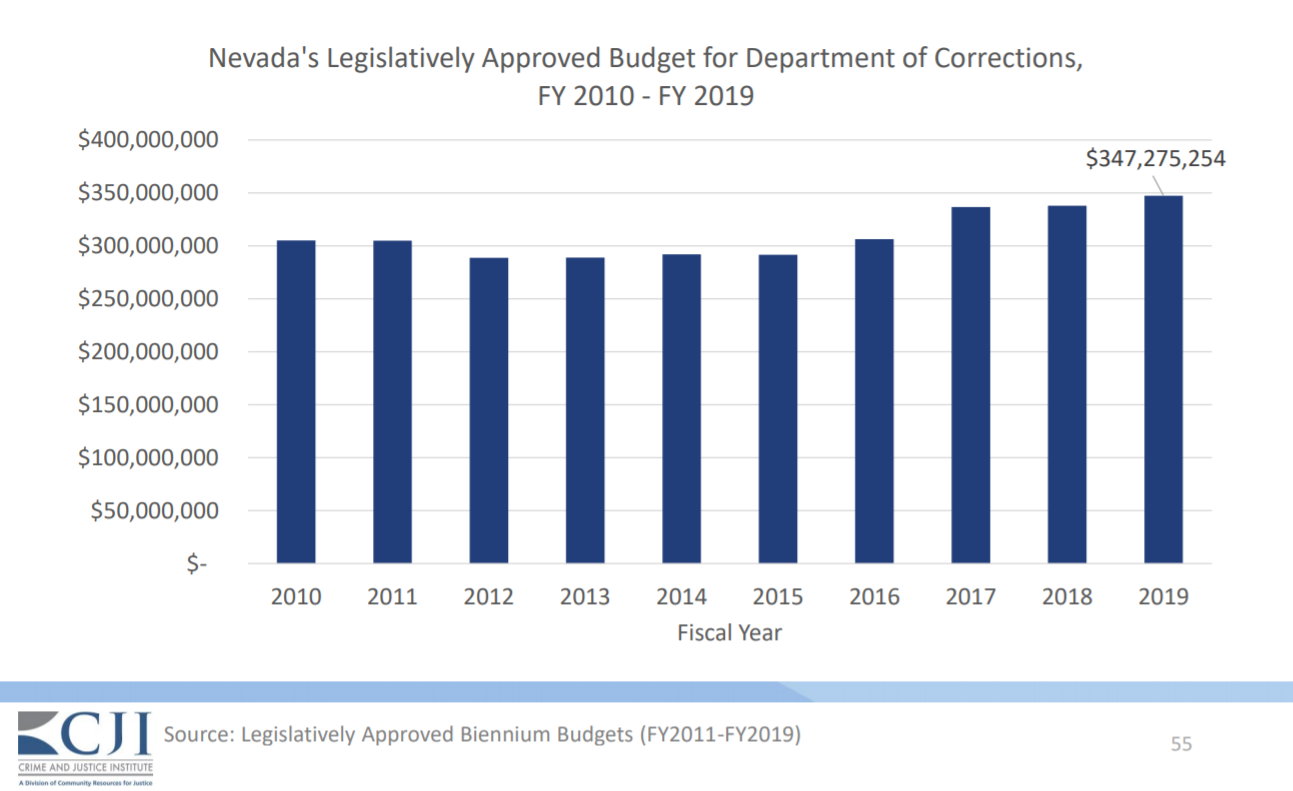
What’s more, there’s a “revolving door” effect that indicates prison, for many offenders, isn’t correcting behavior. The latest statistics show that 29 percent of people released from a Nevada prison in 2014 were reincarcerated within three years.
CJI’s work is funded by a partnership between the Pew Charitable Trusts — a private foundation — and the Department of Justice’s Bureau of Justice Assistance (BJA). Since 2006, the BJA has been carrying out a Justice Reinvestment Initiative, which aims to save states money on correctional costs and then reinvest the savings in initiatives to help reduce crime and recidivism.
CJI has already helped 16 other states analyze and change their criminal justice policies. Len Engel, head of policy and campaigns as the Crime and Justice Institute, said Sandoval had requested similar help for Nevada about three or four years ago, but the institute was busy in other states and couldn’t accommodate the request at the time. CJI reached back out recently to see if it could offer assistance.
“The fact that they are willing to go from state to state with a track record of having improved public safety and also efficiency with public dollars — if they are willing to do an assessment without charging us a penny, then why not take advantage of the opportunity?” Democratic Assembly Speaker Jason Frierson said in an interview.
Five staff members are currently working on the Nevada research project full-time — providing services that the institute values at least a half-million dollars. This fall, they’ll be presenting their findings to Nevada’s long-standing Advisory Commission on the Administration of Justice, which will work with analysts to turn their findings into concrete policies.
The review comes after a push last year in the Legislature to enact more progressive criminal justice policies after a long era of the “tough on crime” approach that leading lawmakers say disproportionately harmed the poor and minorities.
“There’s always ways that we can look at our criminal justice system. There are going to be some areas where penalties need to be increased, and some areas where penalties maybe need to be decreased,” Frierson said. “We have to constantly assess what we’re doing and whether it’s serving as a better way to protect the public.”
The roots of mass incarceration
Nevada incarcerates people more than other states do on average, according to CJI analysts who briefed the Advisory Commission on the Administration of Justice on Aug. 2 about their ongoing research project. The state’s overall incarceration rate is 15 percent higher than the national average, while its female incarceration rate is 43 percent higher than the national average.
“Nevada has a very worrisome growth in prison population and that has generational implications,” Engel said about the trend of women in prison.
Nevada’s prison population is now close to 14,000. While Nevada’s population has grown 250 percent in the past 40 years, the prison population has grown by 900 percent.
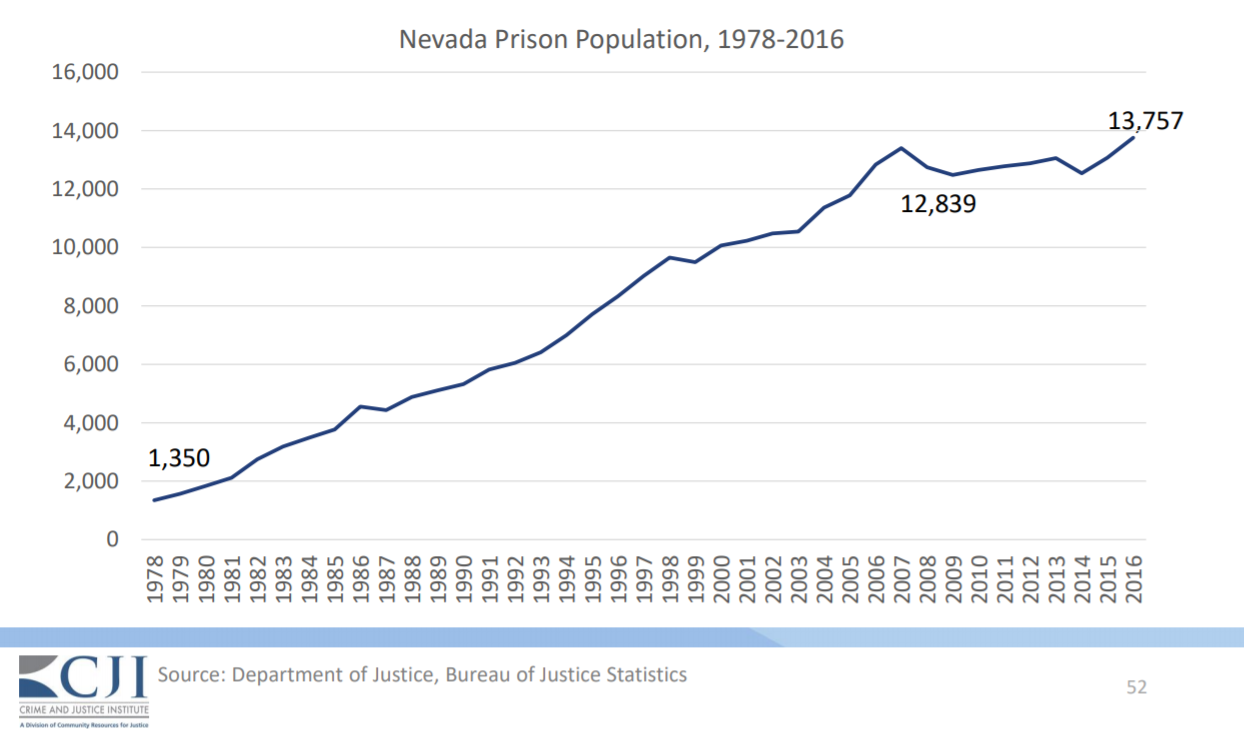
And that’s just in the prison system. Counting people held in local jails, on probation or parole, in federal institutions and in the juvenile justice system, about 39,000 people are under correctional control in Nevada, according to the Prison Policy Institute.
CJI researchers attribute ballooning prison populations nationwide, in part, to the notion that criminals cannot be rehabilitated. They pointed to “What Works?,” an influential 1974 publication from sociologist Robert Martinson.
Data from 231 studies conducted from 1945 to the mid 1960s “give us very little reason to hope that we have in fact found a sure way of reducing recidivism through rehabilitation,” Martinson wrote. The so-called “nothing works” doctrine colored prison policies over the next several decades, leading to harsher sentences and the cancellation of some rehabilitation programs.
The population under correctional control in the U.S. jumped from 1.8 million in 1980 to 7.4 million in 2007. While there were some positive effects — CJI analysts say 10-20 percent of the post-1990s crime decline is attributed to more people being imprisoned and therefore unable to commit crimes in the community — it prompted policymakers to rethink their approach.
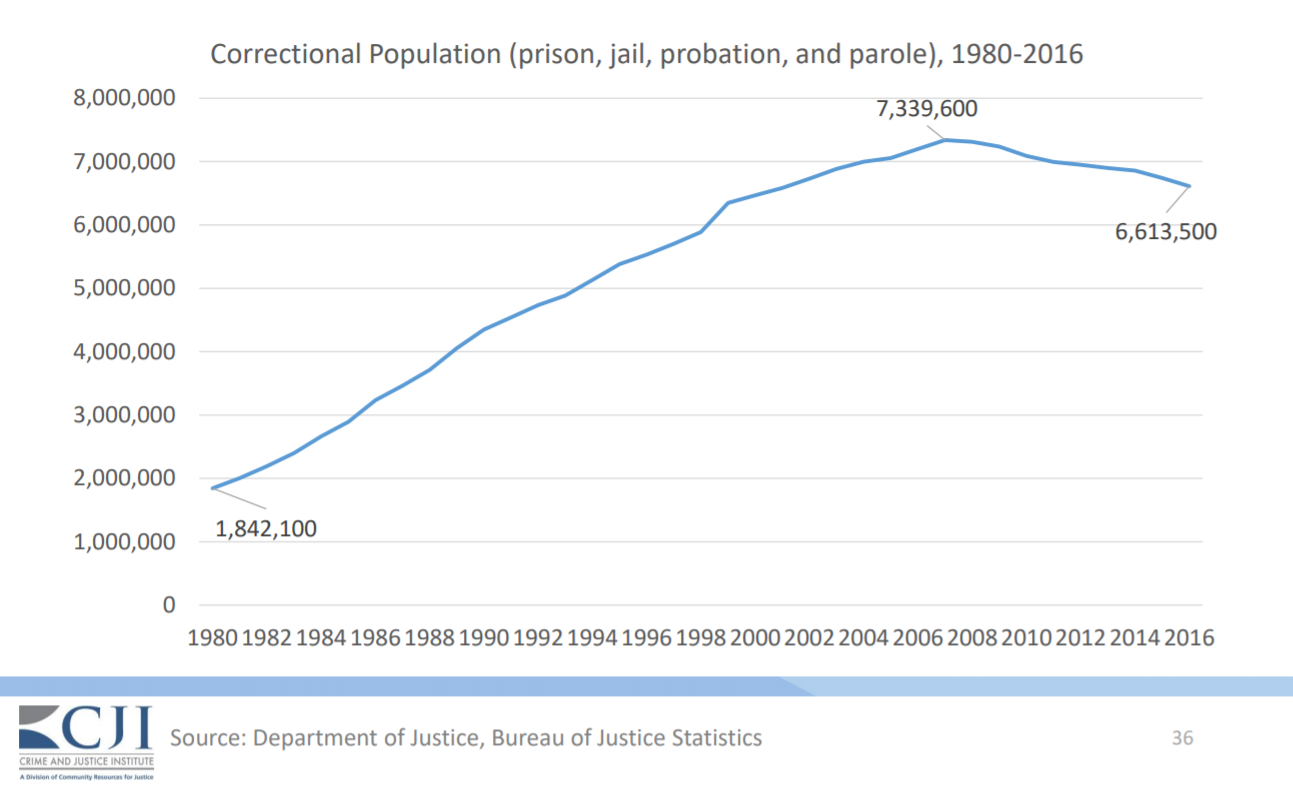
CJI noted that incarceration can serve several different purposes, including being a deterrent for future crime, incapacitating people who might otherwise continue committing crimes, and serving as retribution or a collective rebuke of someone who has violated societal norms.
A fourth purpose is rehabilitating people so they don’t return to their old ways.
Since the time of the Martinson study, CJI staff said, new research has shown that there are in fact ways to change offenders’ criminal behavior patterns. Two they cited are community-based substance abuse treatment and cognitive behavioral therapy, which increases moral reasoning and impulse control.
CJI analysts also say researchers now have a more nuanced view of rehabilitation. Among the consensus points: Incarcerating someone for too long can destabilize their social connections and expose them to peers who are a bad influence, making them more likely to reoffend. High-risk offenders need more supervision when they leave prison, while certain low-risk offenders can be harmed by too much intervention. People should be rewarded for good behavior far more frequently than they should be punished for bad behavior.
CJI staff said many people they’ve interviewed in Nevada’s criminal justice system so far have noted the state’s shortage of mental health services. Analysts clarified that mental illness doesn’t cause criminal behavior, but lack of treatment can be a barrier to rehabilitation and is often associated with substance abuse.
One in four inmates in jail have a serious mental illness, analysts said, while one in 19 in the general population have one. Mental illness is often associated with “entrenchment,” in which an offender stays behind bars longer than they otherwise might.
Using data to tackle the problem
While Nevada doesn’t have to pay for CJI’s services, part of the agreement with the state involved Nevada giving the organization priority access to data sets that encompass the past decade.
Already, analysts have made large requests of the Nevada Department of Corrections and other agencies and started combing through the data.
They gave members of the ACAJ a taste of their work earlier this month, presenting charts that illustrated an increase in the average length of stay at the Clark County Detention Center in spite of a drop in bookings.
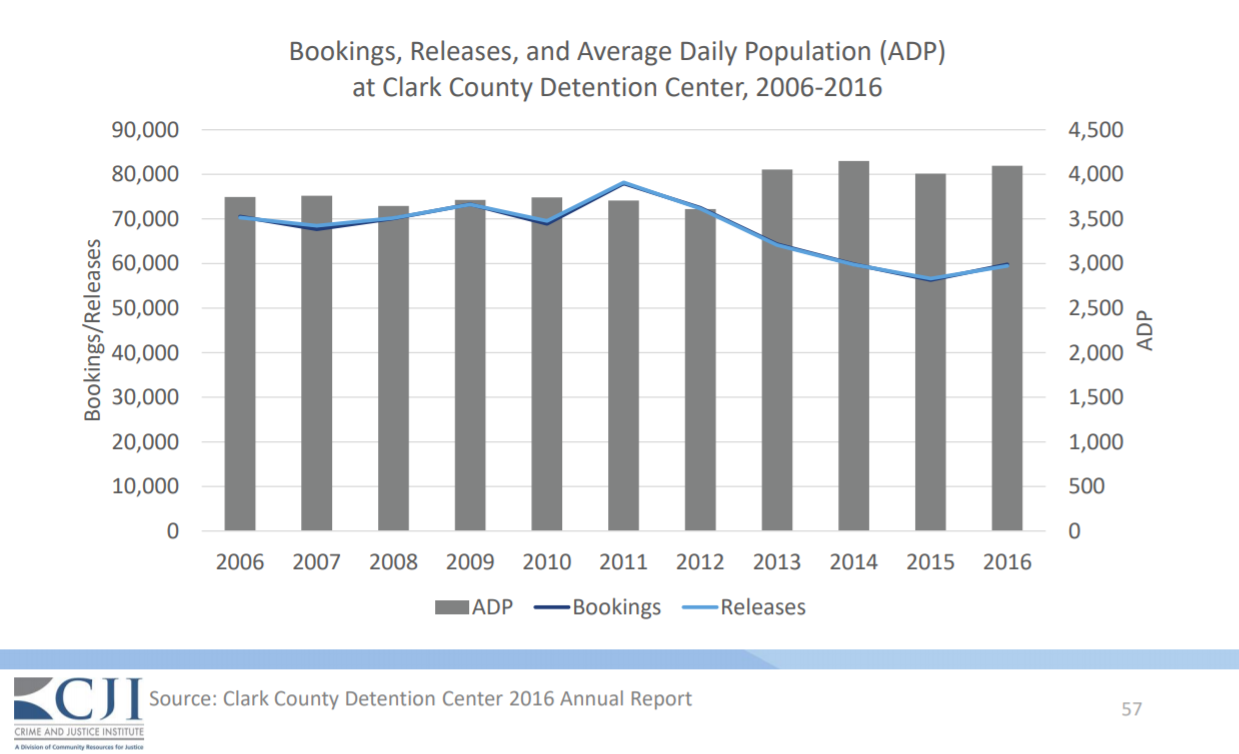
And they showed that in Nevada, a higher ratio of people under “correctional control” (incarceration, parole or probation) are behind bars as opposed to under community supervision. Fifty-two percent of Nevadans under correctional control are incarcerated, while 48 are on parole or probation; nationally, the average is 31 percent incarcerated versus 69 percent on parole or probation.
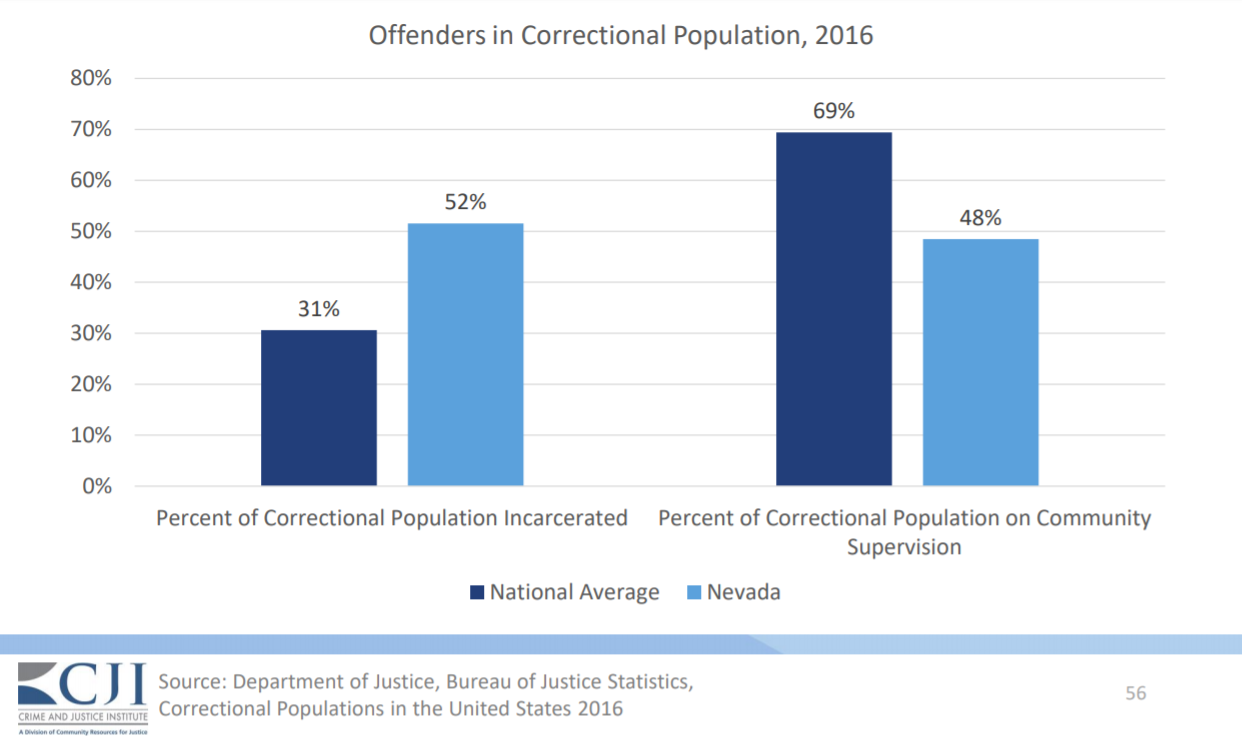
CJI’s focus on data has prompted policy changes in other states where the group has worked. In Louisiana and Mississippi, after CJI’s analysis revealed a large percentage of people were jailed on relatively minor technical parole and probation violations, those states enacted laws limiting the amount of jail time those infractions can carry.
Engle said the data CJI collects from various agencies, which is often in disparate locations and sometimes in difficult-to-analyze formats, often yields surprises for policymakers. Although judges might assert they never send someone to prison solely on a drug possession charge, for example, their own data sometimes tells a different story.
Reinvesting & implementing reforms
In a series of presentations this fall from CJI, members of the ACAJ will have a chance to review data about the drivers of the prison population, and analyses about Nevada’s laws and policies relative to what other states are doing.
From there, they’ll evaluate some potential policy solutions and develop final recommendations for the Legislature’s 2019 session. Engel said CJI analysts will be available throughout the spring to help explain policies to lawmakers using the data they’ve compiled.
If policies become law, CJI will evaluate their effectiveness. Engel said that other states that are further along in the process have seen their adult prison populations decline. But he said CJI-assisted reforms’ effect on recidivism — which generally means whether someone has been re-incarcerated within three years of their release — is harder to track because it requires the passing of more time.
Other states that have evaluated their systems have seen a cost savings. South Carolina saved about $500 million over five years after implementing reforms, although Engel said political hurdles prevented the full sum from being reinvested into crime prevention and rehabilitation activities.
On the other hand, Oklahoma added about $7 million to its budget to improve parole and probation, data collection within the prison system and treatment after undergoing a CJI evaluation. Utah allocated $14-15 million to do similar things, including community-based behavioral health services, CJI said.
One variable on the project’s ultimate effect is the upcoming election. Governors have broad powers through their veto pen, and Sandoval’s opposition blocked a number of criminal justice-related proposals passed by the Democratic-controlled Legislature in 2017. Those included a bill diminishing the role of cash in the bail system, a bill expanding the practice of house arrest for older inmates, and a bill allowing certain marijuana-related convictions to be vacated.
The next governor will be able to accept or reject any proposals that emerge from the advisory commission and then make it through what’s likely to be a Democratic-controlled Legislature.
Asked whether he’ll support the initiative and the recommendations that come out of it, Democratic nominee Steve Sisolak’s spokeswoman, Christina Amestoy, offered this statement:
“Steve supports this initiative. He looks forward to having the chance to review the committee's work as governor and working with the committee and other stakeholders to implement solutions.”
Republican nominee Adam Laxalt is on the advisory committee that will be receiving reports from CJI. Although the Reno Gazette-Journal reported in January that Laxalt said “he would look to implement criminal justice reforms aimed at stopping the ‘revolving door’ of Nevada inmates who find themselves back behind bars after a prison release,” his campaign didn’t respond to a request for comment last week about the CJI initiative and what he would do with recommendations coming out of the committee.
If the effort is a success, it could reflect positively on Sandoval as he heads out of office.
“Smart criminal justice is a priority for my administration and I am confident that we can find ways to both make our communities safer and cut the growing cost of Nevada’s corrections system,” he said in a statement.
